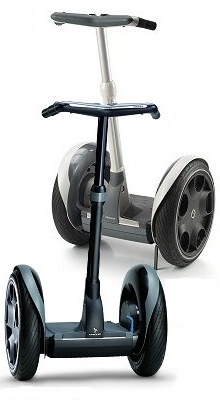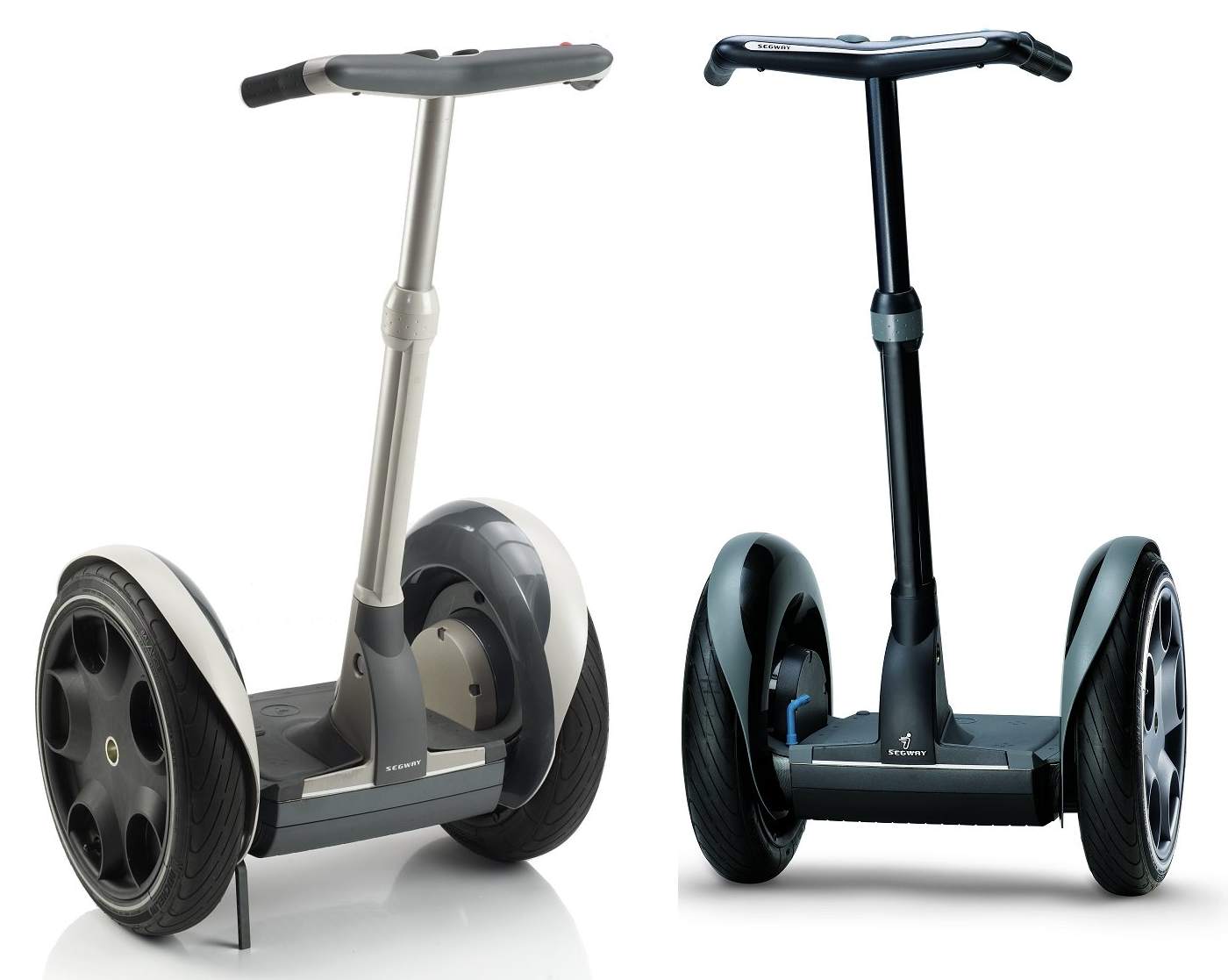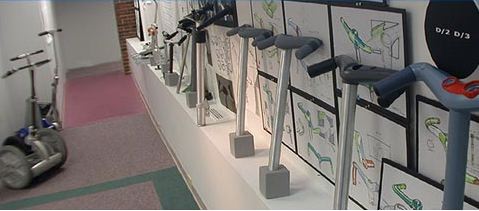


Gallery Commentary
In the Spring of 2004, Segway LLC began asking visitors to their website to fill out opinion Polls soliciting preferred colors for future HT models. The most popular was the color "blue,"
with "black" coming in a close second. Hence it was impressive that the company actually listened to the consumer and within a month they released a new model, the "Midnight Blue" i170, that was dark blue in some parts and undistinguishable from black in others.
Segway as well as some car/motorcycle enthusiasts took note and were impressed with the innovative stylings of the new i170 model. The fenders even had an inlay pattern that made it look like carbon fiber.
It was an extensive and successful style overhaul. One racecar enthusiast commented: "As soon as these get their price down
to $2000, I will be getting one." The initial price was $4,495, but then from July 1st to September 30th 2004 the "Glide Into Summer" promotion added to the purchase a new black (Midnight Blue) upper 12.0 cargo bag and a three-year extended warranty (2 years longer than usual).
The meaning behind the new model number "170" was a shift in nomenclature that likely had nothing to do with a 3% gain in battery life, but rather reflected the concept of an increment of "progress" with a new model.
The Press Release from Segway LLC put it this way:
MANCHESTER, N.H. - June 7, 2004 - Today Segway Inc. added an infusion of color to its expanding line of self-balancing Segway Human Transporters (HTs). The new Segway HT i170 was released today in a new Midnight Blue color that radiates cool and gives riders a new way to express themselves. "The Midnight Blue color adds a new level of depth and diversity to our product lineup that our customers will appreciate," said Segway's Lead Industrial Designer, Scott Waters. "We designed this custom color to look simple at first glance, but when you see it in different environments the dynamic subtleties come to life." The Midnight Blue color palette mingles dark blue tones with grey hues to create a dramatic look while retaining the simple, elegant design of the Segway HT. In addition to its new luster, the i170 model sports fenders with a carbon fiber look and new logo treatments on the handlebar and front trim. Coordinating Segway accessories will be available in the coming months. "The Segway HT is capturing the imagination of people around the country," said Klee Kleber, vice president of marketing, Segway Inc. "As its following increases, customers are seeking new model, color and accessory choices to enhance their Segway experience. This is the first in many options to come." Consumers now have three Segway HT models to choose from, including the i170 in Midnight Blue, the i167 in the original Titanium color and the p133 in Titanium. The i170 model features all of the reliability and performance of the flagship i167 model, including a top speed of 12.5 mph, eight to 12 mile battery range and a total payload of 260 pounds. The Segway HT i170 in Midnight Blue will be available soon at Segway dealerships across the country at the suggested retail price of $4,495. It can also be ordered by calling Segway Inc. toll-free at 1-866-4SEGWAY. Please visit www.segway.com for a complete listing of Segway dealerships.

-Top speed: 12.5 miles per hour (20 kph). This is about three times typical walking speed.
-Weight: 80 lbs (36 kg)
-Width: The Segway's footprint (how much space it covers on the ground) is 19 by 25 inches (48 by 63.5 cm). This makes the Segway about the same width as an average size person, so it doesn't
take up much space on the street. The platform is 8 inches (20 cm) off the ground.
-Weight capacity: 250 pound (110 kg) person with 75 pounds (34 kg) of cargo.
-Range: About 17 miles (28 km) on even ground, with a single charge. Taking uneven terrain into account, Segway's designers estimate the vehicle has a range of 11 miles
(17 km) on a single charge.
-Driver interface: The Segway has a small LCD screen that tells the driver how much battery power is left and how well the vehicle is
functioning. The screen displays a cartoon face, which expresses the general condition of the vehicle. The driver interface is designed to be simple and intuitive.
-Motors: Each of the Segway's wheels is driven by a 2-horsepower electric motor that produce no emissions.
-Transmission: The two-stage transmission, built by Segway and Axicon Technologies, has a compact 24:1 gear ratio. It uses a helical gear assembly that significantly reduces
noise. The Segway team configured the two meshes
in the gear box (the points where gears connect) to make sound exactly two octaves apart. This means the sounds are in harmony, so the gear box make a more musical noise.
The gears are also designed to have noninteger gear ratios, meaning the gear teeth mesh at different points from revolution to revolution. This minimizes wear and tear to
extend the life of the gear box.
-Computer: The Segway's brain is made up of two circuit boards, housed in the vehicle's chassis. The circuit boards, which boast a
total of 10 microprocessors, normally work together, but each can function independently in the event of a computer problem. If one breaks, the other circuit board will
slow the vehicle down gradually to avoid an accident.
-Power: The Segway is powered by two rechargeable batteries. Segways come with either nickel cadmium (NiCd) or
nickel metal hydride (NIMH) batteries. The batteries are constantly monitored by a circuit board, which communicates any performance problems to the central brain. The
batteries can be recharged with household AC current. Dean Kamen estimates a Segway would cost somewhere around 5 cents a day in electricity bills.
-Sensors: The Segway uses five gyroscopes and a collection of other tilt sensors to keep itself upright. Only three gyroscopes are needed -- the extra sensors are included as a safety
precaution. The Segway has an additional weight sensor built into its platform to tell the computer when a rider has stepped on.
-Brakes: The Segway doesn't have a braking system. To stop, the rider stands upright without leaning forward or backward, and the vehicle maintains its position.
-Turning radius: Since it only has two wheels, the Segway can rotate around a single axis (the wheels turn in opposite directions). This gives the Segway a turning radius of zero.
-Wheels: The Segway wheel consists of a forged steel wheel hub with a glass-reinforced thermoplastic rim. Each wheel is secured to the drive shaft with a single nut. The tires are made of a
silica compound, which provides good traction even on wet surfaces.
-Security: The Segway uses an electronic key system. The key, which looks something like a car lighter, stores a 128-bit encrypted digital code. The vehicle won't start unless the key is plugged into its port. The key can also store settings for vehicle operation.
Segways include one key for "beginner mode," where the vehicle has a lower maximum speed, and one key for "experienced mode." Segway plans to offer programmable keys down
the road, which well let users store particular operation settings.
-Chassis: The Segway's sensitive electronic equipment is housed in a sturdy die-cast aluminum chassis. According to Segway, the chassis can withstand 7 tons of force.
-Control shaft: The aluminum shaft that holds up the Segway's handlebars can be adjusted to different heights. Riders can attach clips to the shaft to carry bags or other cargo.

CHANGES: Elements of the original i167 model human transporter that were changed with the introduction of the i170 model included: the Midnight Blue color scheme throughout the HT (all parts that were previously off-white titanium were now dark blue-black), the wheels were also dark blue-black, the kick stand was a lighter blue color (to draw attention to it?), the front trim on the handle bars was changed in shape and styling with Segway logo added, the carbon fiber inlay pattern on the full-size fender (and the new fender molding made it easier to install), small changes in the LED smiley-face display symbols, and some internal changes in the control shaft identified by the blue power/mode button, as well as an altered Segway logo, icon added, on the front trim at the bottom of the control shaft.

